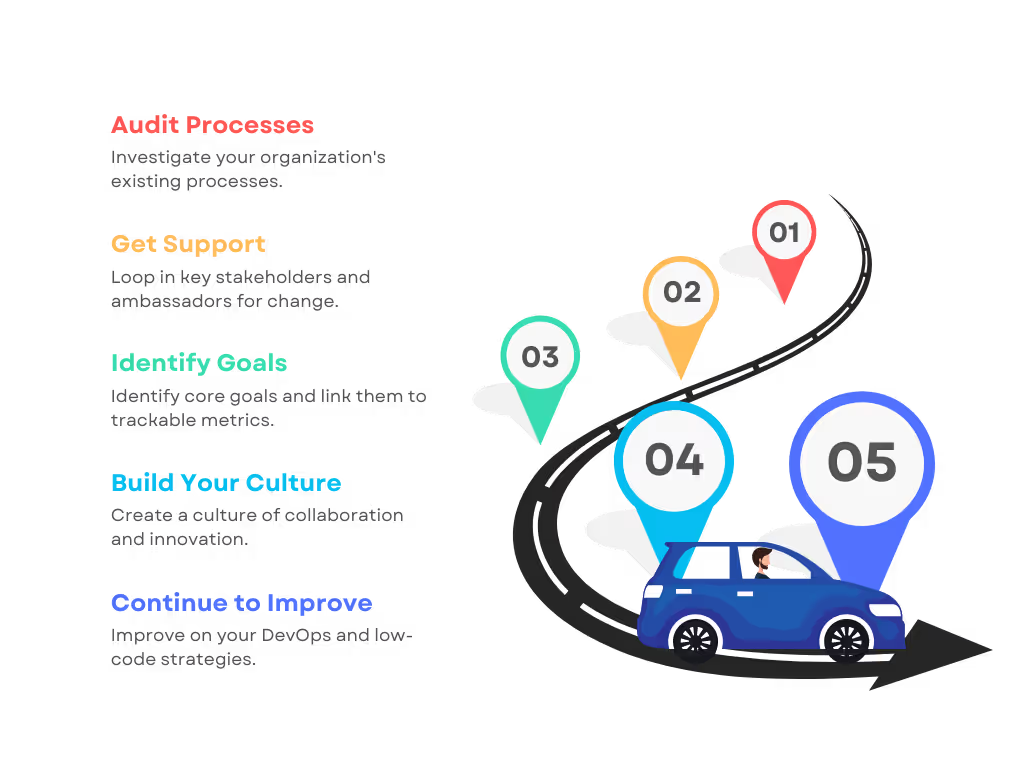

.svg)
.svg)
If you use Salesforce, you’ve seen how low-code development can transform your business. But growing organizations quickly find they need additional support. As you mature, your software delivery practices need to evolve. Testing and CI/CD (Continuous Integration/Continuous Delivery) can help your software development lifecycle scale up to meet business needs. However, these spaces have traditionally required professional developers. Committing to low-code software delivery lets you extend the processes that work well in Salesforce to your whole development cycle, including CI/CD and testing.
But organizations can’t go low-code overnight. Like any business pivot, you’ll need a plan. A DevOps transformation roadmap can help you make the switch to low-code software delivery.
Low-code software development leads to faster deployment — which, in turn, leads to more agile organizations and products that better meet user expectations. Low-code app development yields faster collaboration at lower costs. Organizations can improve their internal processes and their ROI through low-code development.
Today, many organizations are experiencing an “IT drain”; it’s increasingly challenging to hire internal IT employees at a reasonable cost. Whether working with outsourced IT departments or through an internal skeleton crew, commits can take a long time to deploy. That’s time that the organization isn’t performing at its best.
By creating a low-code software environment, organizations can hasten their delivery and better meet their users’ needs. But a transition to low-code software delivery isn’t always easy. Organizations can use their DevOps transformation roadmap to outline the necessary changes to processes, technology and even company culture.

Bake low-code technology into your company’s processes by creating a DevOps transformation roadmap. Your DevOps roadmap will be your driving force throughout your transformation, keeping your team on time and on target.
Consolidate your organization’s data. Map your tech stack. Chart your existing processes. Where are the gaps and overlaps? Which processes must be changed and adjusted?
Low-code strategies will replace and bypass many existing processes, as the organization will no longer rely upon outsourced development teams or a handful of internal experts. Identify the processes that will need to change while also leaving room for feedback and improvements.
CIOs and CTOs must buy into a culture of digital transformation if the transformation is to impact the organization as a whole. Identify key stakeholders and find low-code ambassadors — individuals who are ready, willing and able to dig deeper into the low-code environment and take the critical first steps.
When CIOs, CTOs and CDOs involve themselves in major infrastructure changes, employees are more likely to follow. Digital transformation requires strong leadership, transparency and accountability.
A company can’t be successful if it hasn’t defined its success. Organizations switching to a low-code environment are often doing it for multiple reasons. They want to save money, improve their time-to-deploy or increase client satisfaction. Identify the metrics and goals that are most important to your organization before you start implementing your new low-code strategies.
As you implement your DevOps transformation roadmap, you should see your organization steadily moving toward your core metrics. Your metrics are what will ultimately keep your organization on track and drive your transformation. However, beware of vanity metrics, which can leave you drowning in a sea of useless data. Follow a framework like SMART or DORA to collect valuable, actionable data.
In a transformation-ready culture, employees need to embrace change. Over half of all employees may involve themselves in application changes and change management in low-code companies.
Employees can’t just tolerate change; they must be eager to experience its benefits. Businesses can achieve full buy-in from employees through transparent communication and appropriately set expectations. Show how all of your value streams are connected by translating customer-focused operational value streams into development value streams provided by your teams. Building a connection between customers and employees helps to keep their objectives aligned.
DevOps is never really “complete” — but the entire cycle gets better every time. In your digital transformation roadmap, include improvement plans. How will your low-code processes be audited? How will they get better? And how will information and feedback be passed through the system?
Under a philosophy of continuous improvement, companies must seek stability while prioritizing innovation. Through the Five Steps to DevOps Success, companies can prioritize innovation without sacrificing quality.
Any digital transformation can be a challenge. When transitioning to low-code software development, there are a few major issues to consider.
Without proper management, low-code software delivery can lead to a lack of oversight. If the organization doesn’t already have specialists who can vet the development process, low-coders will struggle with unexpected scenarios or find themselves “testing” the system by going live.
To meet these challenges, you need an industry-capable partner. A knowledgeable partner can help your organization adopt low-code software delivery strategies and minimize confusion or disruption.
Explore our DevOps resource library. Level up your Salesforce DevOps skills today.

.avif)


.svg)
